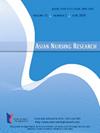Factors Associated With Habitual Drug Use Among Adolescents: A Secondary Data Analysis
IF 2.1
3区 医学
Q2 NURSING
引用次数: 0
Abstract
Purpose
Drug use during adolescence can have lasting health consequences, and understanding the factors that contribute to drug use is essential for effective prevention. This study aimed to identify the factors influencing habitual drug use among South Korean adolescents. It employed Bronfenbrenner's ecological model to examine personal, familial, school-related, and social factors.
Methods
The study analyzed data from the 19th Korea Youth Risk Behavior Survey for 41,928 students from 1st grade of middle school to 3rd grade of high school. Data analysis involved cross-tabulation and logistic regression for complex samples.
Results
The prevalence of habitual drug use was 1.4%. Significant personal factors included smoking [adjusted odds ratio (aOR) = 2.61], alcohol consumption (aOR = 1.55), sexual intercourse (aOR = 1.45), smartphone overdependence (high-risk group aOR = 2.04, potential risk group aOR = 1.31), suicidal ideation (aOR = 2.66), depressed mood (aOR = 1.87), and loneliness (aOR = 1.88). Significant family factors included non-cohabitation with family (aOR = 1.86) and both parents being foreign-born (aOR = 3.36). Experience of violence (aOR = 2.95) was also a significant factor.
Conclusion
This study highlights the need for an integrated approach to prevent adolescent drug use by addressing adolescents’ personal behaviors, family dynamics, and school environments. Prevention programs should account for the influence of multiple systems on habitual drug use. School and community nurses should adopt a comprehensive, multi-dimensional strategy that involves families, schools, and communities to prevent adolescent drug use. Additionally, there is a need to develop family-centered and culturally sensitive drug prevention programs for adolescents.
青少年习惯性药物使用的相关因素:一项二手数据分析。
目的:青春期吸毒会对健康产生持久的影响,了解导致吸毒的因素对于有效预防至关重要。本研究旨在找出影响韩国青少年吸毒习惯的因素。它采用布朗芬布伦纳的生态模型来检验个人、家庭、学校和社会因素。方法:本研究对第19次韩国青少年危险行为调查数据进行分析,调查对象为初中一年级至高中三年级41928名学生。数据分析涉及复杂样本的交叉制表和逻辑回归。结果:吸毒习惯患病率为1.4%。显著的个人因素包括吸烟(校正优势比[aOR] = 2.61)、饮酒(aOR = 1.55)、性交(aOR = 1.45)、智能手机过度依赖(aOR = 2.04)、自杀意念(aOR = 2.66)、情绪抑郁(aOR = 1.87)、孤独感(aOR = 1.88)。显著性家庭因素包括未与家人同居(aOR = 1.86)、父母双方均为外国出生(aOR = 3.36)。暴力经历(aOR = 2.95)也是一个重要因素。结论:本研究强调需要通过解决青少年的个人行为、家庭动态和学校环境来综合预防青少年吸毒。预防计划应该考虑到多重系统对习惯性药物使用的影响。学校和社区护士应采取包括家庭、学校和社区在内的全面、多维战略来预防青少年吸毒。此外,有必要为青少年制定以家庭为中心和具有文化敏感性的毒品预防方案。
本文章由计算机程序翻译,如有差异,请以英文原文为准。
求助全文
约1分钟内获得全文
求助全文
来源期刊

Asian Nursing Research
NURSING-
CiteScore
4.20
自引率
4.50%
发文量
32
审稿时长
45 days
期刊介绍:
Asian Nursing Research is the official peer-reviewed research journal of the Korean Society of Nursing Science, and is devoted to publication of a wide range of research that will contribute to the body of nursing science and inform the practice of nursing, nursing education, administration, and history, on health issues relevant to nursing, and on the testing of research findings in practice.
 求助内容:
求助内容: 应助结果提醒方式:
应助结果提醒方式:


